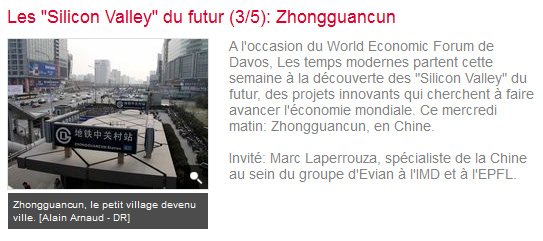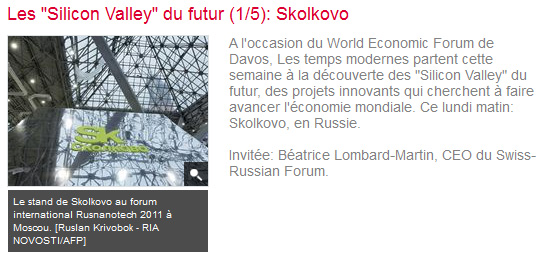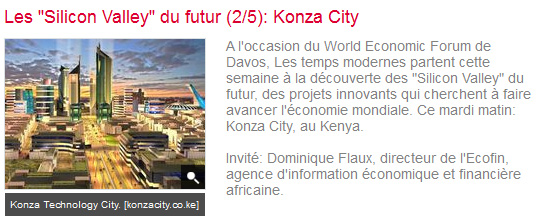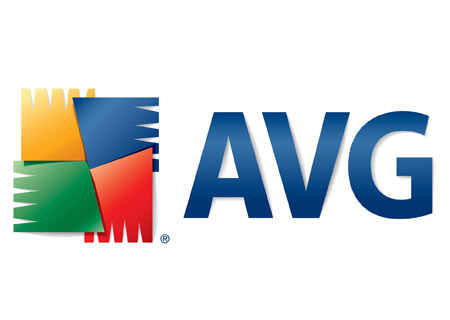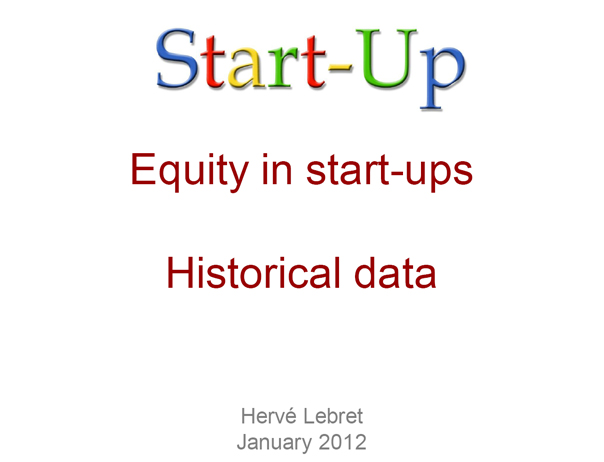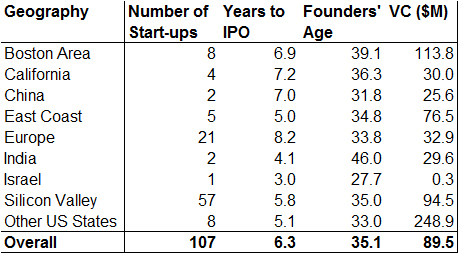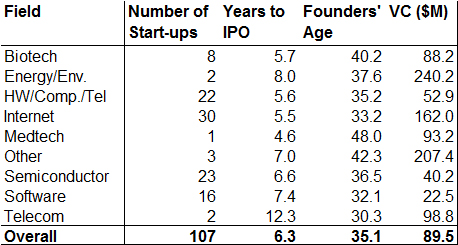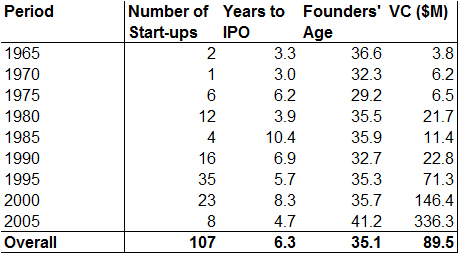My first post for 2012 is a translation of an interview I gave to French magazine La Recherche. It was published last December and you can have an electronic version of the French version here or a pdf document by clicking on the cover page below. It is followed by my own translation. Now I should say that I was a little surprised by the title which I had not expected. I was more thinking in something like “start-ups are the forgotten children of innovation!” The title focused on my cautiousness about IP and patents in particular. It is certainly too strong, but that is what titles are made for…

Patents inhibit innovation, let’s delete them!
Innovation is a matter of culture. An admirer of Silicon Valley, which he has known for twenty years, Hervé Lebret calls for Europe to be inspired by the dynamism and creativity of its start-ups. But is it good to take everything in this model?
La Recherche: A report of the Commission of the European Union stresses that the EU is more increasingly lagging behind the U.S. in terms innovation with a comparable level of research [1]. How do you explain that?
Hervé Lebret: The main reason for this innovation gap in Europe is cultural. I was always struck by how much the students are interested in the applications of research in the U. S., while in Europe we think more in terms of knowledge. And then there are the role models of young entrepreneurs who have experienced success. It is striking in Silicon Valley: Bill Gates was 20 when he founded Microsoft, Steve Jobs 21 when he founded Apple, Larry Page and Sergey Brin, 25 when they created Google. They are powerful models to which a young student can identify to.
La Recherche: The same report argues that another reason for the gap is partly related to differences the patent system which would be more complex and more expensive in Europe. What do you think?
HL: I am skeptical about legislation or rules in general as an explanation in the differences. It is in the people’s head that things happen. In the U.S., they want to try; they have no fear of failure. I am not convinced that we are more innovative because we would have more patents. Look at Switzerland, which has the largest number of patents per capita: this country does not create many start-ups. Incentives and policies are only working if there is a favorable cultural terrain.
La Recherche: But aren’t patents the key for an innovative company, whose value often relies on its intellectual property?
HL: Software is not patentable, and this did not prevent Microsoft to be successful. With the risk that you see me as iconoclastic, I think that patents are an obstacle to innovation. I wonder whether we should not remove them, except perhaps in specific areas, such as biotechnology, where a patent corresponds more specifically to a manufacturing process of a molecule.
But in most industrial fields, you need to own thousands of patents to protect the innovation which is commercialized. The maintenance of this portfolio of patents is extremely expensive and that money could be better used in research and development. Whereas in the past the patent favored the inventor, it has become a defensive weapon to protect dominant positions. Look at the war between Apple and Google: the first alleges that the second has developed its operating system Android by violating certain of its patents. This goes against the theory that the traditional patent protection the weak inventor, who can develop an idea during years without fear of being stolen.
Does the weakness of venture capital, which would deprive young innovative companies from the capital needed for their development, explain some of the shortcomings of innovation in Europe?
H.L. Contrary to general belief, there has always been venture capital in Europe, especially in France. This is not a quantitative but qualitative problem: venture capital in Europe is run by people from finance or consulting, not entrepreneurs.
Again, this is a cultural difference. But this is changing. Former entrepreneurs have recently begun to create venture capital funds or to become business angels. In France, I think of Bernard Liautaud, founder of software company Business Objects, or Xavier Niel, founder of Free, the phone operator, who both joined venture capital firms. The founders of Skype have created Atomico, their own funds.
You do not hide your admiration for Silicon Valley. If the secret of its strength is, as you support, cultural, how can we be inspired in Europe?
H.L. We can draw on customs, practices, an important one being cooperation. In Silicon Valley, curiosity is shared. People know that the exchange of ideas is successful, and are not afraid of ideas being robbed. The two Google founders were PhD students in two different laboratories at Stanford University, but they have talked! It is not unusual o talk to your competitor to solve your own problems: in the 1960s, the major industry semiconductor players in California met at the Wagon Wheel bar in Mountain View to discuss their work. In Europe, many laboratories, academic and probably more private, have a culture of secrecy, they fear the exchange.
What do you put in place at the Ecole Polytechnique Federale de Lausanne (EPFL), where you teach, to develop a taste for innovation and entrepreneurship among students?
H.L. I strongly believe in the role of exemplary models. So I organize conferences with successful entrepreneurs who share their experience. This shows students that these are passionate people, who are not afraid to try, even if just one in a thousand will be successful. These models inspire. But inspiration is nothing without resources. Hence the program “Innogrants”: a salary of one year for a young researcher who is released from its research and teaching in order to concentrate on her or his innovative projects. If it works, it is hoped that the private sector will further invest. Fifty Innogrants were awarded in five years. Half of them have led to the creation of companies in life sciences, micro-or nano or information technology. And five of them have found private investors.
It nevertheless remains modest …
H.L. Yes, we must remain humble: all we can do is create a breeding ground for the creation of innovative companies, as we do with Innogrants. In total, in the last fifteen years, EPFL innovators have created about a dozen start-ups per year. Fifteen have raised venture capital, 300 million Euros in total. Four or five have been sold to industry groups, sometimes these were nice exits. Endoart, founded in 1998 at EPFL specialized in the production of remotely controllable medical implants; it has been sold nine years later for 100 million dollars to Allergan! But we feel there is a kind of modesty, self-restraint of European entrepreneurs compared to their American counterparts.
A former researcher at EPFL criticized the leadership of the university of “copy as closely as possible the American university model” [2]. Do you think everything is good in the American model?
H.L. These criticisms focus on science, not on innovation. The competitive standing of researchers, the instability of the statutes is not a good idea in research. It is very important to let the imagination speak. There is a danger to keep people under permanent pressure. But in terms of innovation, the U.S. model works.
You estimate that at most one in a thousand start-ups meets success. Isn’t this a huge waste?
H.L. We should not measure everything in terms of money or performance. What counts is creativity. For me, the Silicon Valley is the new Athens. As Greece, it is a culture: what this region brought in fifty years is fabulous. Digital technologies that were invented forever changed the way we inform, we cultivate and entertain ourselves. This is probably why the death of Steve Jobs, who was an iconic character, had so many repercussions in October. Furthermore, if one thinks in macroeconomic terms, I do not think that the American model is based on waste only. In the U.S., venture capital weighs about twenty billion dollars a year. For twenty years, 400 billion have been invested. And one company, Google, is now worth $200B. Finally, the creation of economic value is similar to the money invested. It is a collective success, even if it is based on thousands of individual failures, which are often very hard humanely.
The entrepreneur should be at the center of innovation policy
Isn’t the $200 billion market capitalization of Google exaggerated when compared to the actual value of the company?
H.L. The world of venture capital has unfortunately become a financial asset like any other. It is no longer a world of former entrepreneurs who pursue their business while investing in those of others. There is too much money, too much speculation in the U.S. venture capital. But I remember that the start-ups appeared before the Nasdaq, the stock market where shares of high technology companies are traded. Silicon Valley began in the 1960s and 1970s in the context of the counter-culture in California. Steve Jobs did not hesitate to say that some of his creativity came from drugs when he was young. The growing role of finance in the economy only started in the 1980s. Originally, the financiers were the patrons of great artists. That said, I think the current trend of large groups limiting their spending in research and development is catastrophic. Shareholders want 15% return and push to cut spending on research. Good start-up can only emerge if there is also good private research.
Do we see a slowing of the technological innovation?
H.L. I am indeed concerned about the lack of success in current innovation: the 1970s were marked by the transistor, the 1980s by the personal computer; the 1990s by the networks. But in the 2000s, I see nothing new. The Web 2.0 is not a technological revolution, it is a consolidation. More generally, biotechnology was rather disappointing; there is no revolution in energy, chemistry. It is not clear that nanotechnologies are really promising technological breakthroughs. I fear that the 2000s did not create start-ups which are equivalent to Intel in the 1960s, Apple, Microsoft or Genentech in the 1970s, Cisco in the 1980s, or Google in the 1990s. There is Facebook, but this company does not rely on high technology innovation. That said, there has always been a general pessimism about the future of innovation, so I hope to be wrong!
You mention companies in information technology or biotechnology. Is this model of start-up transferable to capital-intensive areas, and where there are already major players, such as aerospace, automotive, chemicals?
H.L. The established players are not necessarily the most innovative. Clayton Christensen from Harvard Business School, showed in 1997 that an established company is great at improving existing products [3]. It is innovation by evolution, not revolution. Renault can invent the electric car, but not a new mode of transportation. Besides, the idea of the minivan, which was then copied, did not come from internal R&D at Renault, but from the company Matra, who did not have the same experience in automotive, which made it more creative. It is also for this reason that the big companies, especially pharmaceuticals, outsource their innovation: they prefer to leave the start-up take the risks, and then buy them. Even an old startup such as Cisco replaces the term “research and development” by “acquisition and development”.
Why do you insist so much on start-ups? An academic institution can also license its patents to the industry, or form mixed private / public laboratories…
H.L. The basic problem is towards whom an innovation policy is directed. My belief is that the entrepreneur must be central. This is not what is done in France: the clusters are clusters of established companies, not tools to promote creativity and entrepreneurship. I insist on start-ups because I think they are the forgotten piece of innovation policies. Of course there is innovation in large groups. But I wonder if they can do disruptive innovative. They can set a goal – the flat screen, the smart phone, or, today, the electric car – that will come out in twenty years. But can they do something entirely new, as did Google? Or Genentech, which revolutionized the manufacture of drugs using genetic engineering techniques? I believe that only start-ups are able to do so. Christensen said if you want to make a major innovation, create a branch and place it as far as possible of your research center as the worst enemy of innovation in a company is conservatism. Innovation is the highest in small teams: this is what happens in the start-up.
■■ Interview by Nicolas Chevassus-au-Louis
[1] European commission, Innovation Union Competitiveness Report 2011, http://ec.europa.eu/research/innovation-union.
[2] Libero Zuppiroli, La Bulle universitaire. Faut-il poursuivre le rêve américain ? Éditions d’en bas, 2010.
[3] Clayton Christensen, The Innovator’s Dilemma, Harper’s, 1997.
Hervé Lebret. A graduate of Ecole Polytechnique and Stanford University, with a Ph.D. in electronics, he worked, after a few years as a researcher, as a venture capitalist, in Geneva from 1997 to 2004. Since then he has been teaching management of technology and manages a seed fund at the Ecole Polytechnique Federale de Lausanne.
> Hervé Lebret, Start-up. What we may still learn from Silicon Valley Create Space, 2007. www.startup-book.com
> www.oecd.org/sti/scoreboard An oecd study on patents
> http://vpiv.epfl.ch/innogrants The site of the Innogrants at EPFL.
